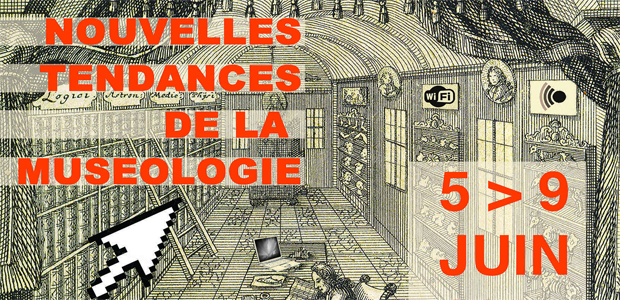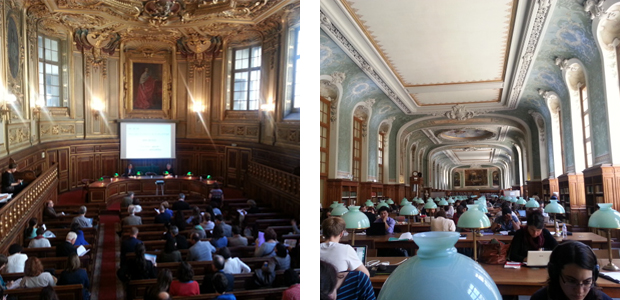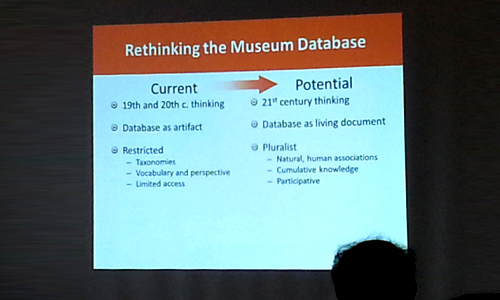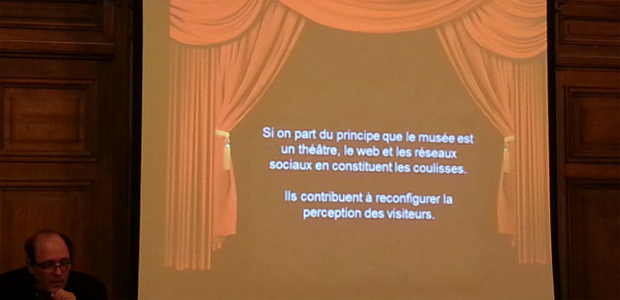Conxa Rodà

By invitation from the Committee of Museology of the ICOM (ICOFOM), the museum participated in the international symposium in the Sorbonne University dedicated to New Trends.
In a changing world and one of accelerated transformation, rethinking the role of the museums and of museology has become a need not only to progress, but almost for survival if we want to be relevant for society. The nine axes of the symposium included Museum ethics in the 21st century, Research on audience, education and communication, the Frontiers of cybermuseology – museums in the digital era, or Participative museology. The publication of all the talks is foreseen in the digital magazine of the ICOFOM, but, meanwhile, I would like to advance some of the features that seemed most significant to me:
■ The exhibition as a media. Daniel Jacobi, emeritus professor of the University of Avignon, highlighted the fact that the temporary exhibitions need to renew their discourse and to invite the public to return, based on the production of something that cannot be found in the museum, that is to say, new content, new research, new museography. In reference to the contemporary practices he poses some questions for debate: Can an exhibition become independent from the collections and from the museums? If an exhibition can be conceived by institutions that are not museums, can they carry them out without the collaboration of those that manage the collections, lead the research, revalue them and spread them?
■ Museums and the economic crisis. Xavier Roigé, University of Barcelona, spoke of three stages of the crisis:
-financial: with closures of museums, reduction of activities, more difficult working conditions
-of the management model: changes in the service charter, efforts to increase the self-funding, differentiation between the museums most moved by the logic of tourism or most focused on the community
-conceptual: differentiated logic between conservation/research and exhibition/spectacle, everything can become heritage, the museums don’t have the exclusiveness of the management of the heritage
He concluded with an interesting concept about the evolution of heritage = conservation to heritage = value of use.

Auditorium and library of the Sorbonne University. Photos: Conxa Rodà
■ New professions. Anna Leshchenko, from the University of Moscow, talked about the new professions that have appeared in recent years with the digital technologies and the growth of staff dedicated to digital tasks. For example the Department of Digital Media of the MET (Metropolitan Museum) went from 10 people in 2008 to 57 in 2013 or the State Hermitage Museum, which currently has 33.
■ Reimagining the online collections. For me one of the most stimulating interventions that opens up new ways for a digital future was the one by Shanon T. Perich of the Smithsonian Museum and Sheila K. Hoffman of the University of Quebec. They explained the project, shortly to be set in motion, of MODD (Material Object Digital Documentation) which proposes a radical re-conception of the museum collections databases. I really liked the image of thinking of the information about an object as if it was its biography, which makes more evident the need to introduce more data into the registers and make those data available to everyone.

■ Digital Trends. My presentation, Museum Digital Trends is uploaded with a Creative Commons license on Slideshare. Here I summarise the 7 digital trends that I believe are more relevant:
– mobile everywhere and to do just about everything
– the user in the centre, improvement of the options of personalisation, social media, co-creation
– content strategy, audiovisual explosion, storytelling, immersive stories
– integrated management of the digital assets within the museum
– eLearning, MOOCs (Massive Open Online Courses)
– augmented reality, 3D printers, gamification, wearables, iBeacons, that is to say, a whole proliferation of multiple technologies that provide us with new ways of approaching heritage, of interpreting, interacting and experimenting
– open content, open data, big data
■ A peripheral view. Marie-Sylvie Poli, from the University of Avignon, spoke of the need to place the public at the centre and to have a peripheral view, and not only from within the museum.
■ From patronage to co-branding. Karina Pronitcheva, from the École du Louvre, spoke of the shift of the luxury brands towards supporting art, that since the 1990s have led to the creation of foundations and major exhibitions. Currently, all this has evolved to an authentic co-branding which joins the museum with a commercial brand, for example, in the joint creation of an exhibition destined to have a major impact on a broad audience.
■ Museum Perspectives. Yves Bergeron, from the University of Quebec, made an excellent synthesis of the three days and highlighted four trends:
-fragmentation: from the collective to the individual
-presentism: acceleration in time, obsession for everything contemporary
-dematerialisation: digital culture, experience of the visit
-socialisation: cultural programmes, museums as spaces of sociability

The symposium was extremely interesting and a necessary meeting point between universities and museums. I was able to confirm that there is still a large gap between the theoretical approach of the museums, which is made in general from the academic world, and the museum practice that, sometimes, is done with a certain lack of deep thinking. An approach between reflection and practice would benefit both aspects, and above all it would be necessary to apply it to the training of new professionals. Meetings such as this one of the ICOFOM surely help.
Related links
Nouvelles tendances de la Muséologie, ICOFOM Studies Series 43 a/ 43 b, pdf
Co-directora del Curs d'Estratègia Digital_UOC_Museu Nacional d'Art de Catalunya
Co-directora del congrés CIMED de Museos y Estrategias Digitales








2 Comments
Bravo! Un très bon article! J’espère que les musées français vont vous lire :-). par contre dommage que vous ne mentionnez pas l’avenir de la fréquentation à court terme, via l’industrie touristique et le e-tourisme, qui impactent tellement les musées (Plus de 50% de leurs visiteurs, tout de même…).Un rapprochement “touristes et habitants” est apparu (Greeters, par ex.), dont il faudrait, à mon avis, mieux tenir compte pour les contenus; des expositions à l’échelle d’une région ou d’une ville se multiplient également (Voyage à Nantes ou Normandie Impressionniste). Et les musées anglais, US ou espagnols savent très bien se préparer au potentiel d’arrivées prévues (+ un milliard de nouveaux touristes en 2030 ou aux visiteurs en ligne. Il ne faudrait pas rater le potentiel, ne pas se replier sur son pays, en ne parlant jamais de ce sujet, non? Encore des félicitations!(Réf. : la publication de la Revue Espaces Juin 2014 :- Dossier “Le Renouveau des musées français”, ( A voir si vous voulez sur :http://www.nouveautourismeculturel.com/blog/2014/06/05/renouveau-musees-francais-en-marche).
Merci bien, Evelyne, très intéressant votre rapport au blog de nouveautourisme culturel.
Effectivement le tourisme culturel est un sujet très important et d’actualité vu qu’il ne cesse d’accroître. Aux séances du symposium auxquelles j’ai assisté on l’a touché bref. Lui seul vaudrait pour une conférence.